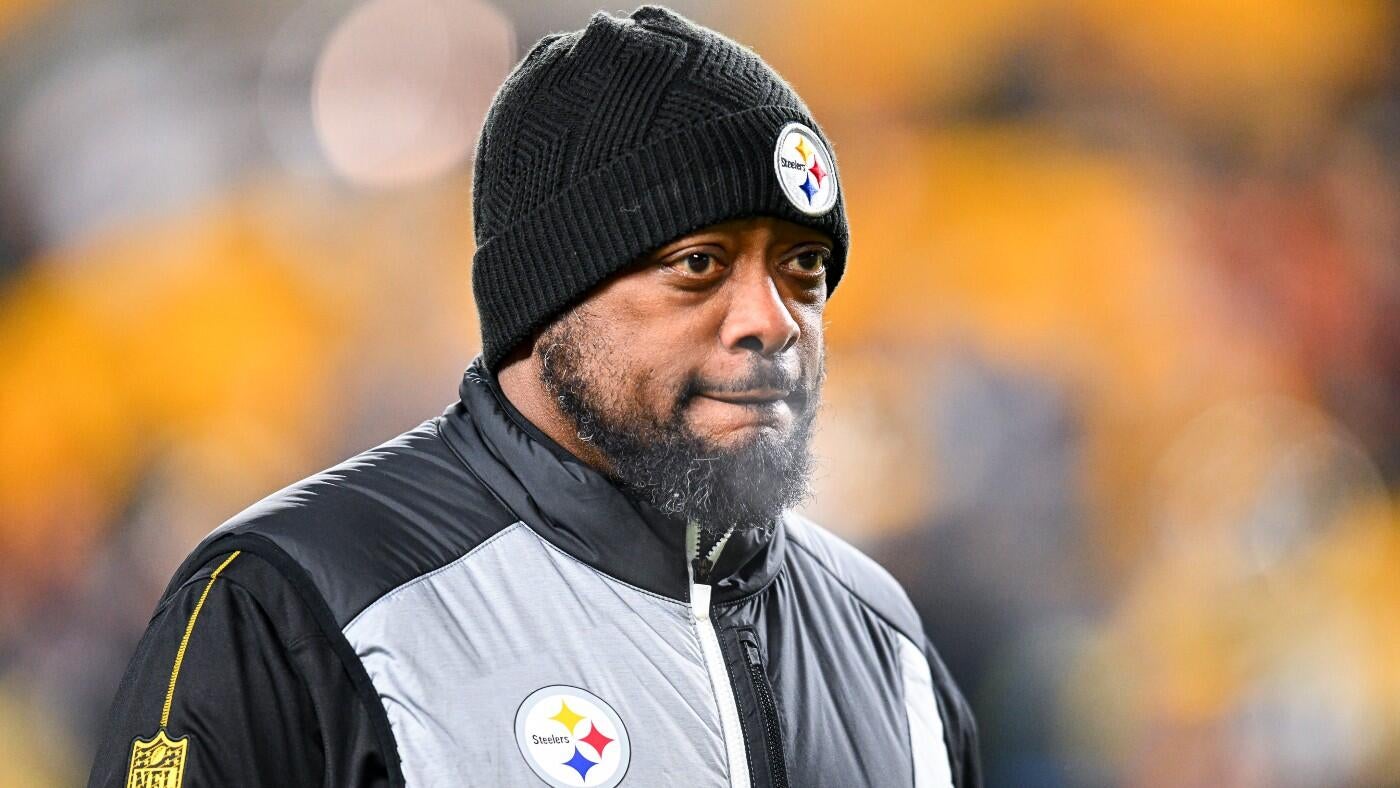

Yes, the Pittsburgh Steelers are acting desperate for Aaron Rodgers: Can you blame them?
Yes, the Pittsburgh Steelers are acting desperate for Aaron Rodgers: Can you blame them?
The Pittsburgh Steelers haven’t exactly had top-flight quarterback play since Ben Roethlisberger left the team after the 2021 season. That is the main reason why the Steelers are in their current predicament: waiting to see if a 41-year-old Aaron Rodgers will sign with them at some point before the start of the 2025 regular season. It may reek of desperation — CBSSports.com’s Cody Benjamin wrote the proud franchise is mired in drama and mediocrity — but it’s still, somehow, the most worthwhile option to pursue.
Coming off another winning, albeit unsatisfying, season, Pittsburgh feels it is an elite quarterback away from contending for the franchises first Super Bowl appearance in 15 years. While their roster isn’t perfect, it does include Pro Bowl wideout DK Metcalf, a young but promising offensive line and a defense that boasts three perennial Pro Bowlers in TJ Watt, Minkah Fitzpatrick and Cameron Heyward.
If Rodgers signs with Pittsburgh, it won’t be that hard for him to be better than the four quarterbacks who were tasked with trying to replace Roethlisberger. One of those quarterbacks, Mason Rudolph (who was re-signed this past offseason after one year with the Titans), is currently in position to start for Pittsburgh if Rodgers ends up not signing.
Are the Steelers lost? As clock ticks on Aaron Rodgers, Pittsburgh is mired in drama and mediocrity
Cody Benjamin

As we continue to wait for Rodgers to make a decision, here’s a sober look at the Steelers’ quarterbacks since Roethlisberger retired. We’ve even ranked them, from worst to best. Warning: It’s not pretty.
This was a no-brainer. The former Chicago Bears’ No. 1 overall pick had a forgettable run as the Steelers’ QB1 that lasted less than four games before he was benched.
Signed at the start of free agency, Trubisky played well enough to help the 2022 Steelers win their season opener in Cincinnati. But his struggles completing passes other than checkdowns was exposed a week later by the New England Patriots, who upset the Steelers in their home opener.
After a second poor performance (a loss in Cleveland on Thursday night in Week 3), Trubisky’s job was officially in jeopardy entering Pittsburgh’s home game against the New York Jets. In the first half, Trubisky tossed a pick and completed just 53.8% of his passes as Pittsburgh trailed 10-6 at intermission. That was enough to compel coach Mike Tomlin to switch to first-round pick Kenny Pickett, thus ending the Trubisky era in Pittsburgh.
Ironically, Trubisky’s best work in Pittsburgh occurred as a backup. His best game as a Steeler took place in Week 6 of that season, when he came in for an injured Pickett and went 9 of 12 for 144 yards and a touchdown (outdueling Tom Brady in the process) in a win over the Buccaneers. Trubisky also had an effective showing in place of Pickett in the Steelers’ Week 15 win over the Panthers in Carolina.
During his time in Pittsburgh, it appeared that Trubisky struggled to find the balance between taking chances and taking what the defense gave him. There were a few instances where he found it, but more often than not, Trubisky looked like a hesitant quarterback who lacked the confidence necessary to play the position at a high level.
After winning six of his first seven starts in Pittsburgh, it appeared that the Steelers may have finally found Roethlisberger’s replacement. Things quickly changed, however, after Wilson and the Steelers bottomed out at the end of the regular season. Pittsburgh lost its final four games before getting drubbed by rival Baltimore in the wild-card round.
Pittsburgh’s five-game losing streak to close out the 2024 season was a team effort, but Wilson’s play during that stretch played a considerable role in the losing. He threw for a paltry 128 yards in a Week 15 loss to the Eagles, committed two massive turnovers a week later in Baltimore, threw an ugly pick in the end zone that contributed to a blowout loss to the Chiefs on Christmas Day, and completed less than 55% of his passes in Pittsburgh’s loss to Cincinnati in the regular-season finale.
It was more of the same in Baltimore in the wild-card round. Wilson’s numbers were good (229 yards and two touchdowns on 20 of 29 passing), but most of his stats came with the game already out of reach.
What changed after the 6-1 start? Along with playing better defenses (for the most part), teams began to realize that all Wilson had was the “moon” ball and checkdown passes. Running and the intermediate passes were no longer part of Wilson’s arsenal. Once teams realized that and made the necessary adjustments, Wilson and the Steelers were dead to rights.
Fields’ lack of time as Pittsburgh’s QB1 is the primary reason why he isn’t ranked higher. While he won 67% of his starts in Pittsburgh, Fields only made six starts and — as he himself acknowledged — didn’t do quite enough in those starts to keep his job.
Pittsburgh’s starter at the beginning of the 2024 season, Fields did what was asked of him for the duration of his time as the Steelers’ QB1. He completed nearly 74% passes while playing risk-adverse ball during Pittsburgh’s Week 1 win in Atlanta. He did more of the same a week later in Denver while helping the Steelers beat a Broncos team that would make the playoffs.
Steelers offensive coordinator Arthur Smith opened more things up for Fields in Week 3, and he responded by throwing for 245 yards (on 25 of 32 passing) that included the game-winning touchdown pass in a win over the Chargers. Fields lost his first start the following week in Indianapolis, but this was still possibly his best game as a Steeler. After a slow start, Fields threw for a season-high 312 yards and a touchdown while also rushing for 55 yards and two scores.
Had Fields followed that performance up with two similar efforts against the Cowboys and Raiders, it’s quite possible that he would have remained the starter. But Fields was just OK in Pittsburgh’s 20-17 loss to the Cowboys, and he was more of a threat on the ground during Pittsburgh’s road win in Las Vegas. Those performances, while decent, were not enough to compel Tomlin from seeing what he had in Wilson.
One can only wonder how the rest of the 2024 season would have unfolded had Tomlin decided to stick with Fields, who will now face the Steelers in Week 1 as the New York Jets’ new starting quarterback.
Getty Images
2. Mason Rudolph (2018-23; 2025)
It was a tough call between Rudolph and the QB just ahead of him on this list. Rudolph was ultimately placed at No. 2 because of his limited reps as the Steelers’ starting quarterback so far.
Another determining factor was Rudolph’s lack of elite-level play. While his performance at the end of the 2023 season was Pittsburgh’s best at the QB position since Big Ben’s retirement, it was just too small of a sample size to place him ahead of the top quarterback on our list.
A 2018 third-round pick, Rudolph was initially brought to Pittsburgh as Roethlisberger’s possible successor. Rudolph didn’t play as a rookie, but he got his chance to play after Big Ben went down with a season-ending injury during the second game of the 2019 season.
Like most young quarterbacks, Rudolph was instructed to be a game manager. With Rudolph largely avoiding mistakes, and with a defense that received a shot in the arm after the in-season trade acquisition of Fitzpatrick, the Steelers were a surprising 8-5 after 13 games. But the Steelers missed the playoffs after losing their final three games, largely due to the lack of quality play at the quarterback.
Rudolph was showing signs of progression before he suffered a nasty concussion near the end of Pittsburgh’s Week 5 loss to the Ravens. Rudolph was never quite the same that season following the injury. Despite that, the Steelers still went 5-3 with him under center that season. They were 0-2 with Roethlisberger and 3-3 with Devlin “Duck” Hodges starting.
Rudolph made just one other start (a tie against then-winless Detroit in 2021) during the next three seasons before he was called into action after Trubisky struggled in relief of injured starter Kenny Pickett late in the 2023 season. Against the Bengals in Week 16, Rudolph shredded Cincinnati’s defense to the tune of 290 yards and two touchdowns while leading the Steelers to a much-needed win. He then threw for 274 yards (while completing 75% of his passes) in a win at Seattle before throwing the game-winning touchdown (and completing 90% of his throws) in a Week 18 win at Baltimore that gave Pittsburgh a playoff berth.
In the playoffs, the Steelers received an OK performance from Rudolph during their 31-17 loss to Buffalo in the wild-card round. Despite his play down the stretch, the Steelers didn’t elect to re-sign Rudolph before the start of free agency. Rudolph, after a year with the Titans, will get another chance in Pittsburgh after signing a two-year deal this offseason.
Rudolph doesn’t have elite mobility, but he is mobile enough to extend plays. Rudolph also has an adequate deep ball, is extremely accurate on short passes and isn’t afraid to take a hit. Rudolph — like a lot of NFL quarterbacks hoping to take the next step — still has room to grow on his intermediate passing.
1. Kenny Pickett (2022-23)
Pickett’s time in Pittsburgh is as controversial as Chicago vs. New York style pizza. Steelers fans who liked Pickett point to the Steelers’ record in games he played the majority of along with the fact that virtually all of his his time in Pittsburgh was spent with an offensive coordinator (Matt Canada) who was fired during the 2023 season. Pickett’s naysayers simply point to the numbers that include a good but not great 14-10 record as a starter and as many interceptions (13) as touchdown passes.
Like many things in life, there’s a lot of gray when it comes to Pickett’s brief career in Pittsburgh. Pickett was undoubtedly better than his raw numbers, but while that is true, you simply can’t ignore the fact that Pickett underwhelmed from a production standpoint.
What also can’t be argued is the fact that Pickett was put in a less than ideal situation when he entered the Steelers’ starting lineup during Pittsburgh’s eventual Week 4 loss to the Jets. Pickett scored two touchdowns that day, but his three picks sealed Pittsburgh’s 24-20 loss. Pickett actually threw for a career-high 327 yards the following week in Buffalo, but those yards came in a 38-3 defeat.
After a 3-7 start, Pickett won his last five starts (that saw him play in the majority of the game) while helping the Steelers finish with a 9-8 record. Pickett’s highlights during that stretch included game-winning touchdown passes in consecutive weeks (including in Baltimore in Week 17) as the Steelers kept their playoff hopes alive.
Expectations were high for Pickett and the Steelers entering 2023, but Pittsburgh was quickly brought back to reality after Pickett and Co. were pushed around by the eventual NFC champion 49ers in Week 1. With each week, it became more and more clear that Canada was in over his head. It finally took an inexcusable loss in Cleveland in mid-November before a change was finally made.
With Canada out and Eddie Faulker/Mike Sullivan filling in at OC, Pickett threw for 279 yards in leading the Steelers to a road with over the Bengals, improving Pittsburgh’s record to 7-4. At home against the Cardinals one week later, Pickett had the Steelers offense in position to score the go-ahead touchdown before he suffered an ankle sprain that ultimately sidelined him for the rest of the season.
The Steelers lost that day to the Cardinals, the first of three straight setbacks that left the Steelers at 7-7. But the Steelers won their final three games to make the playoffs while riding the hot hand of Rudolph, who then became the first Steelers quarterback since Roethlisberger to start a playoff game.
Pickett, who was unceremoniously traded to Philadelphia in March 2024, did not materialize into the player the Steelers certainly hoped he would be. But while that much is true, it’s also true that Pickett wasn’t put in the best position to succeed when you look at the coaching and the offensive talent (or lack thereof) that surrounded him. Like Big Ben did in his final seasons, Pickett played behind a transitioning offensive line. Pickett also had two receivers (George Pickens and Diontae Johnson) who at times failed to complete routes and other plays that surely contributed to them eventually being traded away by the team.
You also can’t ignore the fact that the Steelers were 12-4 in Pickett’s final 16 games where he played in the majority of the contest. He didn’t have the best of stats in Pittsburgh, but Pickett was more than OK when it comes to the stat that matters most: winning.



